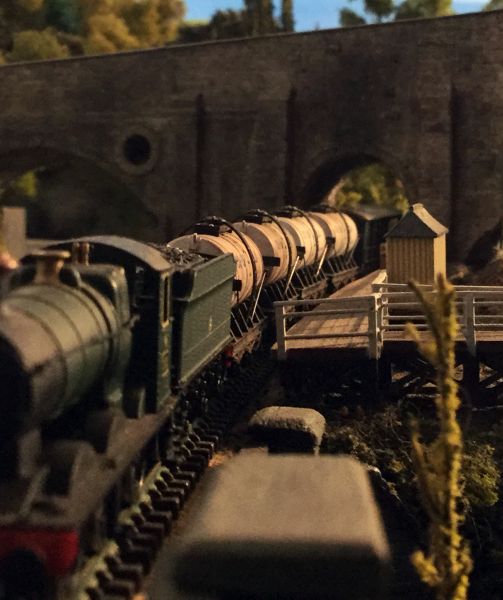Plastic wheeled on carriages and wagons
Posted
#239993
(In Topic #13291)
Full Member
Posted
Site staff

Ron
NCE DCC ; 00 scale UK outline.
NCE DCC ; 00 scale UK outline.
Posted
Full Member
grandad.
Posted
Full Member
Posted
Full Member
Swings and roundabouts and some random DITD comments.
Plastic wheels: Quieter, no risks of electrical shorts across points, cheaper, same profile as metal ones, easy to paint/weather with solvent paints, no issues with magnetic decoupling systems if axle is plastic. Attract dust (electrostatic, not an issue with Delrin)), lack weight, easier to damage, axle pockets need cleaning more, one piece wheels and axles are impossible to regauge, plastic wheels on metal axles can drift out of gauge, impossible to use for electrical pickup from track.
Metal wheels give weight, but are difficult to paint unless treated appropriately. The plastic axle bush can fail, or with older design wheels the thin insulating strip between tread and wheel will fail (Romford wheels). Beware old stock, the wheel sets can be half insulated. Use a multimeter to check. Use non magnetic axles if possible. UK sets tend to be steel. They can be replaced with brass.
I have stock with plastic wheels and axles that runs fine after 10 years use, if the track is clean the treads need cleaning at about the same frequency as metal ones. If you like the noise then go metal.
Invest in an axle pocket profiler. It will improve the running of both types of wheels. Dirty pockets are the major cause of friction. Wheel sets from one supplier may not be the same weight or profile as those from another. Horny vs Alan Gibson Workshop or Ultrascale for example. Fine scale vs run of the mill is another. Decide on one supplier if possible.
Subjective observation, but increasing the weight/mass at the ends of carriages or long freight wagons that originally had plastic wheels needs some added weight in the middle. The NMRA weight/ length guide is useful. Most UK stock is too light.
Nigel
©Nigel C. Phillips
Posted
Full Member
grandad.
Posted
Full Member
Shed, daughter and SIL, house to be built? Sounds like it's plank time! Piece of whatever, 3'-4' by 8"-10" is enough for a track or two and a siding (or even an inglenook), and will let you get those skills back. Five feet by 15" sits on an ironing board. Just saying. And it will stack out of the way in a cupboard or on a shelf. It may even turn into a real micro-layout with a fiddle yard. And no cold and damp days in the shed. 😊😊😊
Nigel
PS We have been storing "stuff" belonging to the tin lids for 6 years now. Once in a while we take a box and turn up with it. I have no idea what they do with it.
©Nigel C. Phillips
Posted
Full Member
,Hi bcdr, why did I not think of that, getting old,I think, we’ll have done it now. Learning functions on locos which are fitted with hornby TTS sound.Eric.
I I

Posted
Full Member
Model railway layout without tears. Branch line terminus lurking there. Make sure you have insulated joiners between those facing points!
Nigel
©Nigel C. Phillips
Posted
Full Member
Posted
Full Member
Sorry, had another look at the photo. Are they Hornby insulfrogs? If you have live (metal) frogs and exit rails that take the polarity of the point blades (called power routing) facing points can short unless there are insulators (or gaps). Both exit rails have the same polarity. From memory not an issue with plastic frogs (it has been a long time since I used them).
Nigel
©Nigel C. Phillips
Posted
Full Member
Hope my rambling on not to boring, but nice to have some one to talk to about it. Many thanks for “ talking “about to all.
Eric
P.S finger now aching:)
Posted
Full Member
Ask away, we've all been there. Or will be as this hobby is one long learning exercise. As long as the locomotive wheelbase is longer than the frog it will work fine. As will the point blades as long as the contact with the rails is good and clean. I always add wires to the point blades as well as the closure rails, but mine are usually hand built or heavily modified RTR points/turnouts.
Nigel
©Nigel C. Phillips
Posted
Full Member
Small planks are great for developing the modelling skills and getting one to completion is achievable in a reasonable time frame.
Once completed I was able to show the missus something like this to support my "land grab" for a spare room.

Get on with it Grandad! You've made a great start.
;-)



Marty
1 guest and 0 members have just viewed this.

